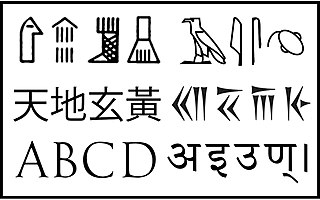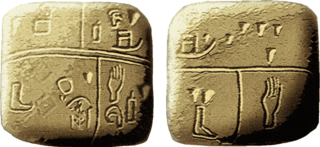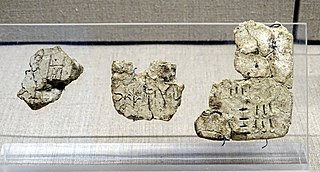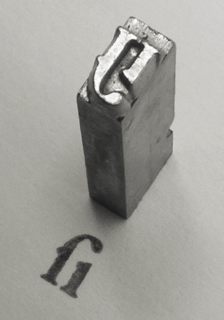 W
WThe history of writing traces the development of expressing language by letters or other marks and also the studies and descriptions of these developments.
 W
WThe writing systems used in ancient Egypt were deciphered in the early nineteenth century through the work of several European scholars, especially Jean-François Champollion and Thomas Young. Ancient Egyptian forms of writing, which included the hieroglyphic, hieratic and demotic scripts, ceased to be understood in the fourth and fifth centuries AD, as the Coptic alphabet was increasingly used in their place. Later generations' knowledge of the older scripts was based on the work of Greek and Roman authors whose understanding was faulty. It was thus widely believed that Egyptian scripts were exclusively ideographic, representing ideas rather than sounds, and even that hieroglyphs were an esoteric, mystical script rather than a means of recording a spoken language. Some attempts at decipherment by Islamic and European scholars in the Middle Ages and early modern times acknowledged the script might have a phonetic component, but perception of hieroglyphs as purely ideographic hampered efforts to understand them as late as the eighteenth century.
 W
WThe Early Cyrillic alphabet, also called classical Cyrillic or paleo-Cyrillic, is a writing system that was developed in the First Bulgarian Empire during the late 9th century on the basis of the Greek alphabet for the Slavic peoples living near the Byzantine Empire in South East and Central Europe. It was used by Slavic peoples in South East, Central and Eastern Europe.
 W
WThe Latin script is the most widely used alphabetic writing system in the world. It is the standard script of the English language and is often referred to simply as "the alphabet" in English. It is a true alphabet which originated in the 7th century BC in Italy and has changed continually over the last 2,500 years. It has roots in the Semitic alphabet and its offshoot alphabets, the Phoenician, Greek, and Etruscan. The phonetic values of some letters changed, some letters were lost and gained, and several writing styles ("hands") developed. Two such styles, the minuscule and majuscule hands, were combined into one script with alternate forms for the lower and upper case letters. Due to classicism, modern uppercase letters differ only slightly from their classical counterparts. There are few regional variants.
 W
WThe Kish tablet is a limestone tablet found at Tell al-Uhaymir, Babil Governorate, Iraq – the site of the ancient Sumerian city of Kish. A plaster-cast of the artifact is today in the collection of the Ashmolean Museum.
 W
WThe history of printing starts as early as 3500 BCE, when the proto-Elamite and Sumerian civilizations used cylinder seals to certify documents written in clay. Other early forms include block seals, hammered coinage, pottery imprints, and cloth printing. Initially a method of printing patterns on cloth such as silk, woodblock printing originated in China around 200 AD, and was transferred to paper by the 7th century, leading to the spread of book production in Asia. Movable type was invented in the Song dynasty in the eleventh century but it received limited use compared to woodblock printing. Woodblock printing was also used in Europe until the fifteenth century when a process for mass-producing metal type and the printing press were invented to support an economical book publishing industry. This industry enabled the communication of ideas and sharing of knowledge on an unprecedented scale. Alongside the development of text printing, new and lower-cost methods of image reproduction were developed, including lithography, screen printing and photocopying.
 W
WRecorded history or written history is a historical narrative based on a written record or other documented communication. It contrasts with other narratives of the past, such as mythological, oral or archeological traditions. For broader world history, recorded history begins with the accounts of the ancient world around the 4th millennium BC, and coincides with the invention of writing. For some geographic regions or cultures, written history is limited to a relatively recent period in human history because of the limited use of written records. Moreover, human cultures do not always record all of the information relevant to later historians, such as the full impact of natural disasters or the names of individuals. Recorded history for particular types of information is therefore limited based on the types of records kept. Because of this, recorded history in different contexts may refer to different periods of time depending on the topic.
 W
WThis article discusses the geographic spread of the Latin script throughout history, from its archaic beginnings in Latium to the dominant writing system on Earth in modernity.
 W
WModern typographers view typography as a craft with a very long history tracing its origins back to the first punches and dies used to make seals and coinage currency in ancient times. The basic elements of typography are at least as old as civilization and the earliest writing systems—a series of key developments that were eventually drawn together into one systematic craft. While woodblock printing and movable type had precedents in East Asia, typography in the Western world developed after the invention of the printing press by Johannes Gutenberg in the mid-15th century. The initial spread of printing throughout Germany and Italy led to the enduring legacy and continued use of blackletter, Roman and italic types.